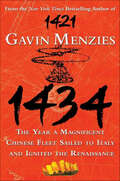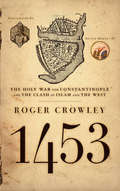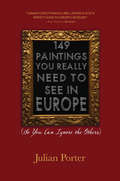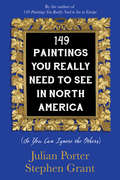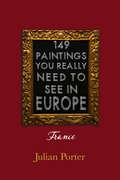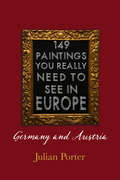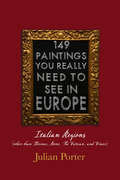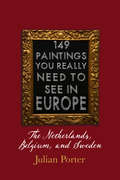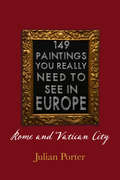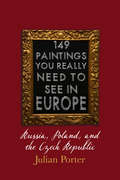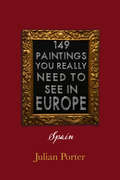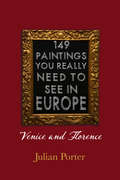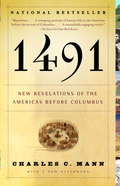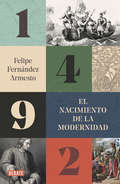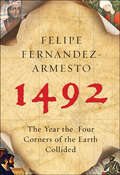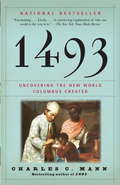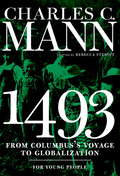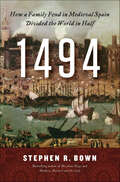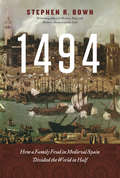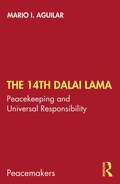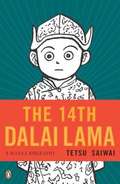- Table View
- List View
1434: The Year a Magnificent Chinese Fleet Sailed to Italy and Ignited the Renaissance
by Gavin MenziesThe New York Times bestselling author of 1421 offers another stunning reappraisal of history, presenting compelling new evidence that traces the roots of the European Renaissance to Chinese exploration in the fifteenth centuryThe brilliance of the Renaissance laid the foundation of the modern world. Textbooks tell us that it came about as a result of a rediscovery of the ideas and ideals of classical Greece and Rome. But now bestselling historian Gavin Menzies makes the startling argument that in the year 1434, China—then the world's most technologically advanced civilization—provided the spark that set the European Renaissance ablaze. From that date onward, Europeans embraced Chinese intellectual ideas, discoveries, and inventions, all of which form the basis of western civilization today.Florence and Venice of the early fifteenth century were hubs of world trade, attracting traders from across the globe. Based on years of research, this marvelous history argues that a Chinese fleet—official ambassadors of the emperor—arrived in Tuscany in 1434, where they were received by Pope Eugenius IV in Florence. The delegation presented the influential pope with a wealth of Chinese learning from a diverse range of fields: art, geography (including world maps that were passed on to Christopher Columbus and Ferdinand Magellan), astronomy, mathematics, printing, architecture, steel manufacturing, military weaponry, and more. This vast treasure trove of knowledge spread across Europe, igniting the legendary inventiveness of the Renaissance, including the work of such geniuses as da Vinci, Copernicus, Galileo, and more.In 1434, Gavin Menzies combines this long-overdue historical reexamination with the excitement of an investigative adventure. He brings the reader aboard the remarkable Chinese fleet as it sails from China to Cairo and Florence, and then back across the world. Erudite and brilliantly reasoned, 1434 will change the way we see ourselves, our history, and our world.
1436: The First Pure Chinese Luxury Fashion Brand?
by Anat Keinan Hannah H. Chang Sandrine CrenerCase
1453: The Holy War for Constantinople and the Clash of Islam and the West
by Roger CrowleyA gripping exploration of the fall of Constantinople and its connection to the world we live in today.The fall of Constantinople in 1453 signaled a shift in history and the end of the Byzantium Empire. Roger Crowley's readable and comprehensive account of the battle between Mehmet II, sultan of the Ottoman Empire, and Constantine XI, the 57th emperor of Byzantium, illuminates the period in history that was a precursor to the current conflict between the West and the Middle East.
149 Paintings You Really Need to See in Europe: (So You Can Ignore the Others)
by Julian PorterVisit some of Europe’s greatest museums and galleries in the company of a knowledgeable tour guide. "Who can resist an art critic with attitude?" – Former Supreme Court of Canada Justice, Ian Binnie "It was wonderful! Julian shared his enormous knowledge of the world’s best art with a panache that is irresistible." – Justice Stephen Goudge, Ontario Court of Appeal This essential companion to all the major European museums and galleries discusses some of the world’s greatest paintings from Giotto through to Picasso. Julian Porter’s passion for art began with the seven years he spent as a student tour guide in Europe. Since then, he has conducted countless tours of Europe’s famous galleries – The Louvre, The Prado, The Hermitage, The Rijksmuseum, the Sistine Chapel, and many others. In the usually pretentious arena of art connoisseurs, Porter’s voice stands out as fresh and original. He finds the best of the best, which he describes with entertaining irreverence, and spares you hours of sore feet and superfluous information.
149 Paintings You Really Need to See in North America: (So You Can Ignore the Others)
by Julian Porter Stephen GrantTour North America’s greatest museums and galleries in the company of two incomparable guides. This lively companion highlights the essential paintings, by some of the world’s greatest painters, from Giotto to Picasso, on display in North American museums and galleries. Julian Porter has had a life-long passion for art. He worked for seven years as a student tour guide in Europe and since has conducted countless gallery tours in Europe and North America. His co-author, Stephen Grant, brings a wealth of expertise in twentieth-century artists, and presents them within the framework of a North American–led, sustained burst of originality and shock. Presented with wit and irreverence, here is the best that North American galleries have to offer. Focused and curated to give you everything you need to enjoy the greatest works of art in the best company and save you the sore feet and superfluous information.
149 Paintings You Really Should See in Europe — France
by Julian PorterThis chapter from Julian Porter’s essential companion to all the major European museums and galleries discusses some of the greatest paintings to be found in the museums and galleries of France. His passion for art began with the seven years he spent as a student tour guide in Europe. In this segment he visits Paris and discusses works by masters such as Delacroix, David, Renoir, Manet, Degas, and many more. In the usually pretentious arena of art connoisseurs, Porter’s voice stands out as fresh and original. He finds the best of the best, which he describes with entertaining irreverence, and spares you hours of sore feet and superfluous information.
149 Paintings You Really Should See in Europe — Germany and Austria
by Julian PorterThis chapter from Julian Porter’s essential companion to all the major European museums and galleries discusses some of the greatest paintings to be found in the museums and galleries of Germany and Austria. His passion for art began with the seven years he spent as a student tour guide in Europe. In this segment he visits Berlin, Vienna, Dresden, and Munich and discusses works by masters such as Rembrandt, Watteau, Raphael, Van Eyck, Dürer, and many more. In the usually pretentious arena of art connoisseurs, Porter’s voice stands out as fresh and original. He finds the best of the best, which he describes with entertaining irreverence, and spares you hours of sore feet and superfluous information.
149 Paintings You Really Should See in Europe — Great Britain and Ireland
by Julian PorterThis chapter from Julian Porter’s essential companion to all the major European museums and galleries discusses some of the greatest paintings to be found in the museums and galleries of the United Kingdom and Ireland. His passion for art began with the seven years he spent as a student tour guide in Europe. In this segment he visits London, Dublin, and the university towns of Cambridge and Oxford and discusses works by masters such as Constable, Turner, Waterhouse and many more. In the usually pretentious arena of art connoisseurs, Porter’s voice stands out as fresh and original. He finds the best of the best, which he describes with entertaining irreverence, and spares you hours of sore feet and superfluous information.
149 Paintings You Really Should See in Europe — Italian Regions (other than Florence, Rome, The Vatican, and Venice)
by Julian PorterThis chapter from Julian Porter’s essential companion to all the major European museums and galleries discusses some of the greatest paintings to be found in the museums and galleries of Italy. His passion for art began with the seven years he spent as a student tour guide in Europe. In this segment he visits Milan, Arezzo, Parma, Mantua, Assisi, Naples, Orvieto, and Padua and discusses works by masters such as Titian, Tintoretto, Bellini, Giotto, and many more. In the usually pretentious arena of art connoisseurs, Porter’s voice stands out as fresh and original. He finds the best of the best, which he describes with entertaining irreverence, and spares you hours of sore feet and superfluous information.
149 Paintings You Really Should See in Europe — The Netherlands, Belgium, and Sweden
by Julian PorterThis chapter from Julian Porter’s essential companion to all the major European museums and galleries discusses some of the greatest paintings to be found in the museums and galleries of The Netherlands, Belgium, and Sweden. His passion for art began with the seven years he spent as a student tour guide in Europe. In this segment he visits Amsterdam, Stockholm, The Hague, Bruges, Antwerp and Ghent and discusses works by the Dutch masters such as Vermeer, Rembrandt, and Van Eyck, but also Van Gogh and Renoir. In the usually pretentious arena of art connoisseurs, Porter’s voice stands out as fresh and original. He finds the best of the best, which he describes with entertaining irreverence, and spares you hours of sore feet and superfluous information.
149 Paintings You Really Should See in Europe — Rome and Vatican City
by Julian PorterThis chapter from Julian Porter’s essential companion to all the major European museums and galleries discusses some of the greatest paintings to be found in the museums and galleries of Rome and the Vatican, including the Sistine Chapel. His passion for art began with the seven years he spent as a student tour guide in Europe. In this segment he discusses works by masters such as Michelangelo, Caravaggio, and Raphael. In the usually pretentious arena of art connoisseurs, Porter’s voice stands out as fresh and original. He finds the best of the best, which he describes with entertaining irreverence, and spares you hours of sore feet and superfluous information.
149 Paintings You Really Should See in Europe — Russia, Poland, and the Czech Republic
by Julian PorterThis chapter from Julian Porter’s essential companion to all the major European museums and galleries discusses some of the greatest paintings to be found in the museums and galleries of Russia, Poland, and the Czech Republic. His passion for art began with the seven years he spent as a student tour guide in Europe. In this segment he visits St. Petersburg, Krakow, and Prague and discusses works by masters such as da Vinci, Matisse, Dürer, and many more. In the usually pretentious arena of art connoisseurs, Porter’s voice stands out as fresh and original. He finds the best of the best, which he describes with entertaining irreverence, and spares you hours of sore feet and superfluous information.
149 Paintings You Really Should See in Europe — Spain
by Julian PorterThis chapter from Julian Porter’s essential companion to all the major European museums and galleries discusses some of the greatest paintings to be found in the museums and galleries of Spain. His passion for art began with the seven years he spent as a student tour guide in Europe. In this segment he visits Madrid and Toledo and discusses works by masters such as Goya, Bosch, Velázquez, Picasso, El Greco, and many more. In the usually pretentious arena of art connoisseurs, Porter’s voice stands out as fresh and original. He finds the best of the best, which he describes with entertaining irreverence, and spares you hours of sore feet and superfluous information.
149 Paintings You Really Should See in Europe — Venice and Florence
by Julian PorterThis chapter from Julian Porter’s essential companion to all the major European museums and galleries discusses some of the greatest paintings to be found in the museums and galleries of Florence and Venice. His passion for art began with the seven years he spent as a student tour guide in Europe. In this segment he discusses works by masters such as Tintoretto, Botticelli, Veronese, and many more. In the usually pretentious arena of art connoisseurs, Porter’s voice stands out as fresh and original. He finds the best of the best, which he describes with entertaining irreverence, and spares you hours of sore feet and superfluous information.
1491: The Americas Before Columbus
by Charles MannIn this groundbreaking work of science, history, and archaeology, Charles C. Mann radically alters our understanding of the Americas before the arrival of Columbus in 1492. Contrary to what so many Americans learn in school, the pre-Columbian Indians were not sparsely settled in a pristine wilderness; rather, there were huge numbers of Indians who actively molded and influenced the land around them. The astonishing Aztec capital of Tenochtitlan had running water and immaculately clean streets, and was larger than any contemporary European city. Mexican cultures created corn in a specialized breeding process that it has been called man's first feat of genetic engineering. Indeed, Indians were not living lightly on the land but were landscaping and manipulating their world in ways that we are only now beginning to understand. Challenging and surprising, this is a transformative new look at a rich and fascinating world we only thought we knew.
1492: El nacimiento de la modernidad
by Felipe Fernández-ArmestoGuerras, brujería, plagas y persecuciones, ciencia, magia y profecías, arte y fe, las glorias y miserias de 1492 nos hablan de un mundo en movimiento en este relato deslumbrante que constituye una auténtica historia global del nacimiento de la modernidad. Profetas, adivinos y astrólogos auguraron que el mundo terminaría en 1492. Tenían razón. Su mundo acabó y empezó el nuestro. Este fascinante viaje de la Edad Media a la modernidad nos explica los acontecimientos que hicieron posible el mundo en que vivimos: el aumento de los intercambios comerciales y sus efectos en la economía mundial, la forma en que las principales civilizaciones y religiones dividieron el mundo o el cambio en la distribución de la riqueza. De la mano de un guía extraordinario como Felipe Fernández-Armesto, y en compañía de los viajeros auténticos que hicieron posible la transformación, asistimos en Granada, Pekín, Estambul o Tombuctú, y a personajes comoIván el Terrible, Alejandro Borgia, Colón o Zheng He, que protagonizaron este momento de transición.
1492
by Felipe Fernández-ArmestoProfetas, adivinos y astrólogos auguraron que el mundo terminaría en 1492. Tenían razón. Su mundo acabó y empezó el nuestro.Este fascinante viaje de la Edad Media a la modernidad nos explica los acontecimientos que hicieron posible el mundo en que vivimos: el aumento de los intercambios comerciales y sus efectos en la economía mundial, la forma en que las principales civilizaciones y religiones dividieron el mundo o el cambio en la distribución de la riqueza. De la mano de un guía extraordinario como Felipe Fernández-Armesto, y en compañía de los viajeros auténticos que hicieron posible la transformación, asistimos en Granada al derrumbe del último reino islámico en Europa occidental y al renacer de un nuevo imperio islámico en Tombuctú; visitamos la corte del primer rey cristiano en el hemisferio sur junto a los exploradores portugueses y nos unimos a los judíos expulsados de España al cruzar el Mediterráneo hasta el norte de África, Italia y Estambul; presenciamos los funerales de Lorenzo el Magnífico en una afligida Florencia y paseamos por la Roma corrupta de Alejandro Borgia; recorremos las heladas fronteras de la sangrienta Rusia de Iván el Terrible y escuchamos a los poetas místicos cantar en las costas del Océano Índico; en las profundidades de un viejo cráter de las Canarias contemplamos el nacimiento del primer imperio europeo de ultramar, navegamos por el Atlántico con Colón y conocemos a incas y aztecas antes de que sucumban a la fundación de un nuevo mundo en las Américas.Guerras, brujería, plagas y persecuciones, ciencia, magia y profecías, arte y fe, las glorias y miserias de 1492 nos hablan de un mundo en movimiento en este relato deslumbrante que constituye una auténtica historia global del nacimiento de la modernidad.
1492: The Year the Four Corners of the Earth Collided
by Felipe Fernandez-ArmestoA study of events of 1492 and how they affect the global community of the world of today.The world would end in 1492—so the prophets, soothsayers and stargazers said. They were right. Their world did end. But ours began.In search of the origins of the modern world, 1492 takes readers on a journey around the globe of the time, in the company of real-life travellers, drawing together the threads that began to bind the planet: from the way power and wealth are distributed around the globe to the way major religions and civilizations divide the world. Events that began in 1492 even transformed the whole ecological system of the planet. Wars and witchcraft, plagues and persecutions, poetry and prophecy, science and magic, art and faith—all the glories and follies of the time are in this book.
1492
by Newton Frohlich Ramón Hervás1492 pone en escena a los grandes protagonistas de al epopeya del descubrimiento de América: Cristóbal Colón, la reina Isabel de Castilla, el rey Fernando de Aragón.
1493: Uncovering the New World Columbus Created
by Charles MannFrom the author of1491—the best-selling study of the pre-Columbian Americas—a deeply engaging new history of the most momentous biological event since the death of the dinosaurs. More than 200 million years ago, geological forces split apart the continents. Isolated from each other, the two halves of the world developed radically different suites of plants and animals. When Christopher Columbus set foot in the Americas, he ended that separation at a stroke. Driven by the economic goal of establishing trade with China, he accidentally set off an ecological convulsion as European vessels carried thousands of species to new homes across the oceans. The Columbian Exchange, as researchers call it, is the reason there are tomatoes in Italy, oranges in Florida, chocolates in Switzerland, and chili peppers in Thailand. More important, creatures the colonists knew nothing about hitched along for the ride. Earthworms, mosquitoes, and cockroaches; honeybees, dandelions, and African grasses; bacteria, fungi, and viruses; rats of every description—all of them rushed like eager tourists into lands that had never seen their like before, changing lives and landscapes across the planet. Eight decades after Columbus, a Spaniard named Legazpi succeeded where Columbus had failed. He sailed west to establish continual trade with China, then the richest, most powerful country in the world. In Manila, a city Legazpi founded, silver from the Americas, mined by African and Indian slaves, was sold to Asians in return for silk for Europeans. It was the first time that goods and people from every corner of the globe were connected in a single worldwide exchange. Much as Columbus created a new world biologically, Legazpi and the Spanish empire he served created a new world economically. As Charles C. Mann shows, the Columbian Exchange underlies much of subsequent human history. Presenting the latest research by ecologists, anthropologists, archaeologists, and historians, Mann shows how the creation of this worldwide network of ecological and economic exchange fostered the rise of Europe, devastated imperial China, convulsed Africa, and for two centuries made Mexico City—where Asia, Europe, and the new frontier of the Americas dynamically interacted—the center of the world. In such encounters, he uncovers the germ of today’s fiercest political disputes, from immigration to trade policy to culture wars. In1493,Charles Mann gives us an eye-opening scientific interpretation of our past, unequaled in its authority and fascination.
1493 for Young People
by Rebecca Stefoff Charles Mann1493 for Young People by Charles C. Mann tells the gripping story of globalization through travel, trade, colonization, and migration from its beginnings in the fifteenth century to the present. How did the lowly potato plant feed the poor across Europe and then cause the deaths of millions? How did the rubber plant enable industrialization? What is the connection between malaria, slavery, and the outcome of the American Revolution? How did the fabled silver mountain of sixteenth-century Bolivia fund economic development in the flood-prone plains of rural China and the wars of the Spanish Empire? Here is the story of how sometimes the greatest leaps also posed the greatest threats to human advancement.Mann's language is as plainspoken and clear as it is provocative, his research and erudition vast, his conclusions ones that will stimulate the critical thinking of young people. 1493 for Young People provides tools for wrestling with the most pressing issues of today, and will empower young people as they struggle with a changing world.From the Hardcover edition.
1494: How a Family Feud in Medieval Spain Divided the World in Half
by Stephen R. BownAn “exciting” account of the feud between monarchs, clergy, and explorers that split the globe between Spain and Portugal and made the oceans a battleground (Kirkus Reviews).When Columbus triumphantly returned to Spain in 1493, his discoveries inflamed an already-smoldering conflict between Spain’s monarchs, Ferdinand and Isabella, and Portugal’s João II. Which nation was to control the world’s oceans? To quell the argument, Pope Alexander VI—the notorious Rodrigo Borgia—issued a proclamation laying the foundation for the Treaty of Tordesillas of 1494, an edict that created an imaginary line in the Atlantic Ocean dividing the entire known (and unknown) world between Spain and Portugal.Just as the world’s oceans were about to be opened by Columbus’s epochal voyage, the treaty sought to limit the seas to these two favored Catholic nations. The edict had a profound influence on world history: it propelled Spain and Portugal to superpower status, steered other European nations on a collision course, and became the central grievance in two centuries of international espionage, piracy, and warfare.It also began the fight for “the freedom of the seas”—the epic struggle to determine whether the oceans, and thus global commerce, would be controlled by an autocrat’s decree or open to the ships of any nation—a distinctly modern notion championed in the early seventeenth century by Dutch legal theorist Hugo Grotius, whose arguments became the foundation of international law.At the heart of one of the greatest international diplomatic and political agreements of the last five centuries were the strained relationships and passions of a handful of powerful individuals. They were linked by a shared history, mutual animosity, and personal obligations—quarrels, rivalries, and hatreds that dated back decades. Yet the struggle ultimately stemmed from a young woman’s determination to defy tradition and the king, and to choose her own husband.“Incorporates a sprawling cast of characters, including Ferdinand and Isabella, Columbus, Magellan, Sir Francis Drake, and members of the ostentatious Borgia clan, into what is both a judicious synthesis of the surrounding scholarship and an entertaining look at the evolution of international law on the high seas.” —Booklist“A starry love story, a tale of seething jealousies and subterfuge, a political imbroglio, and religious cruelties. It sounds like Shakespeare and it could have very well been the plot of one of his plays.” —Toronto Star“An entertaining and elegantly written voyage into the treacherous seas of religious fanatics, greedy slavers, depraved autocrats, doomed indigenous peoples and desperately brave adventurers in search of fortune.” —Globe & Mail
1494
by Stephen R. BownWhen Columbus triumphantly returned from America to Spain in 1493, his discoveries inflamed an already-smouldering conflict between Spain's renowned monarchs, Ferdinand and Isabella, and Portugal's João II. Which nation was to control the world's oceans? To quell the argument, Pope Alexander VI - the notorious Rodrigo Borgia - issued a proclamation laying the foundation for the Treaty of Tordesillas, an edict that created an imaginary line in the Atlantic Ocean dividing the entire known (and unknown) world between Spain and Portugal.Just as the world's oceans were about to be opened by Columbus's epochal voyage, the treaty sought to limit the seas to these two favoured Catholic nations. The edict was to have a profound influence on world history: it propelled Spain and Portugal to superpower status, steered many other European nations on a collision course and became the central grievance in two centuries of international espionage, piracy and warfare.At the heart of one of the greatest international diplomatic and political agreements of the last five centuries were the strained relationships and passions of a handful of powerful individuals. They were linked by a shared history, mutual animosity and personal obligations.
The 14th Dalai Lama: Peacekeeping and Universal Responsibility (Peacemakers)
by Mario I. AguilarThis book outlines the life of spiritual diplomacy of the 14th Dalai Lama and his emergence as a global peace icon. It traces his evolution as a Tibetan Buddhist monk rooted in the Geluk tradition, as a Nobel laureate, and as an internationally recognized peacemaker. The volume brings to the fore the Dalai Lama’s monastic life grounded in the compassion and ethical responsibility of a bodhisattva, somebody who is willing to renounce samsara for the benefit of others, as well as that of a political leader of Tibet. It examines the deep impact of his ideas of peacekeeping and universal responsibility on world politics, which draw on acceptance, inclusion, and respect as their central pillars. Further, this book highlights his departure from the practices of the earlier Dalai Lamas, and how the Chinese invasion and his exile in India transformed him into a universal figure of peace, rather than solely being the leader of Tibet. An introspective read, this book will be of much interest to readers interested in spiritual diplomacy and political philosophy. It will also be of interest to scholars and researchers of peace and conflict studies, international relations, politics, and religion, especially Buddhism.
The 14th Dalai Lama: A Manga Biography
by Tetsu SaiwaiA new way of getting to know one of the world's most beloved spiritual leaders. Featuring a charmingly illustrated format that will appeal to readers of all ages, this unique biography is an ideal introduction to the leader of the Tibetan government-in-exile. Born in 1935 to a peasant family in a small village, Tenzin Gyatso was recognized at the age of two as the reincarnation of his predecessor, the Thirteenth Dalai Lama. In 1950, His Holiness assumed full political power when China invade Tibet-a tragedy that forever changed him and shaped his efforts on behalf of world peace, for which he was award the Nobel Peace Prize. This graphic novel is an appealing and approachable depiction of the life and personality of an iconic figure. <P><P> <i>Advisory: Bookshare has learned that this book offers only partial accessibility. We have kept it in the collection because it is useful for some of our members. Benetech is actively working on projects to improve accessibility issues such as these.</i>
